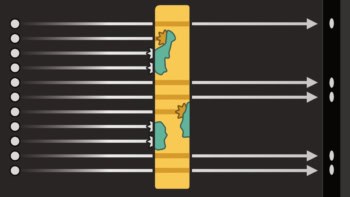By Hamish Johnston
Before the days of the budget airline free-for-all, most aeroplanes were boarded in row-number blocks – with passengers seated at the rear section of the plane going first.
While this method is widely believed to be more efficient than everyone piling on at once (apparently it isn’t) some folks had suspected that better schemes could be found.
There are two main ways in which passengers can interfere with each other and slow down the boarding process. In “aisle interference”, a passenger who is stowing a bag in an overhead locker prevents people from moving further into the plane. In “seat interference”, seated passengers move into the aisle to allow others to sit down, slowing down boarding.
In addition to block boarding, several other schemes have been proposed to minimize interference. These include “Wilma”, which begins with all window-seat passengers followed by all those seated in the middle and finally the aisle seats. Others, such as the method proposed in 2008 by Fermilab physicist Jason Steffen, take a more prescriptive approach, defining the precise order in which each passenger boards the plane.
In Steffen’s scheme, passengers are boarded back to front, but in such a way that adjacent passengers in the line are seated two rows apart (12A followed by 10A and 8A, for example). This is done to ensure that each person has enough room to stow their bags. Those in window seats are also boarded before middle and aisle seats.
Now Steffen, along with the television producer Jon Hotchkiss, has done a series of experiments to try to work out which boarding method is the quickest. The experiment was filmed for a television programme called This vs That and you can watch the trailer above.
The measurements were made using a mock fuselage of a Boeing 757 aircraft in Studio City, California, that is normally usually used for film production. The “passengers” ranged in age from about 5 to 65 and were given hand luggage to load into lockers. The plane had 12 rows of six seats with one aisle running up the middle.
Using the traditional block boarding method, it took nearly seven minutes for all passengers to take their seats – more than two minutes longer than when the passengers boarded at random. The Wilma technique clocked in at just over four minutes, whereas Steffen’s method was the quickest, taking about three and a half minutes to fill the plane.
However, the most surprising result occurred when the plane was boarded in back-to-front order. This started with the passenger in the rear right window seat, followed by the rear left window seat, the rear right middle seat and so on. This highly regimented method took over six minutes to fill the plane – showing that a free-for-all can be more efficient than a highly regimented plan.
You can read a preprint describing the experiment here.



